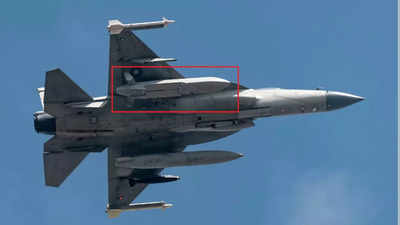- News
- World News
- Pakistan News
- Pakistan arming JF-17 jets with Ra'ad nuke missiles
Trending
Pakistan arming JF-17 jets with Ra'ad nuke missiles
A recent image from the 2023 Pakistan Day Parade rehearsals revealed a JF-17 Thunder Block II aircraft carrying a Ra'ad-I air-launched cruise missile, marking its first public observation. This indicates Pakistan's progress in equipping JF-17s for nuclear capabilities, potentially replacing the ageing Mirage III/Vs. The development occurs amid regional nuclear arms competition and heightened tensions between Pakistan, India, and China.

JF-17 aircraft (Photo credit: Rana Suhaib/Snappers Crew)
A recent image captured during rehearsals for the 2023 Pakistan Day Parade has shed light on the potential nuclear capabilities of Pakistan's JF-17 Thunder Block II aircraft. The photograph depicts a JF-17 carrying what appears to be a Ra'ad air-launched cruise missile (ALCM), marking the first public observation of this configuration.
Analyzing images of a JF-17 Thunder Block II from the 2023 Pakistan Day Parade rehearsals, the Federation of American Scientists (FAS) confirmed that the fighter jet was equipped with a Ra'ad-I nuclear missile."Notably, this was the first time such a configuration had been observed in public," the FAS said in its report.
To determine the specific type of Ra'ad missile in the image, comparisons were made with Ra'ad-I and Ra'ad-II missiles displayed in previous Pakistan Day Parades. While the Ra'ad-II, first unveiled in 2017, was presented as having nearly double the range capability of the Ra'ad-I, external features did not clearly distinguish the two versions until 2022. The latest Ra'ad-II, displayed in 2022 and 2024, features a distinct 'x-shaped' tail fin configuration, while the missile photographed on the JF-17 more closely resembles the 'twin-tail' configuration of the Ra'ad-I, the FAS report said.
Using Photoshop's Vanishing Point feature and reference measurements from the vehicles carrying the missiles, the lengths of the Ra'ad-I and Ra'ad-II were estimated to be around 4.9 meters each. The missile on the JF-17 was also measured using the aircraft's length as a reference, resulting in a similar 4.9-meter estimate. These measurements, along with the tail fin configuration, suggest that the missile observed on the JF-17 is likely the Ra'ad-I ALCM rather than the newer Ra'ad-II or the conventional anti-ship variant, Taimoor, the FAS report by Eliana Johns said.
These developments occur amidst an ongoing nuclear arms competition in the region, with Pakistan, India, and China pursuing advanced technologies such as multiple independently targetable re-entry vehicles (MIRVs). The heightened tensions and the development of short-range, lower-yield nuclear-capable systems by Pakistan have raised concerns about accelerated arms racing and escalation risks in a potential conflict between India and Pakistan.
Analyzing images of a JF-17 Thunder Block II from the 2023 Pakistan Day Parade rehearsals, the Federation of American Scientists (FAS) confirmed that the fighter jet was equipped with a Ra'ad-I nuclear missile."Notably, this was the first time such a configuration had been observed in public," the FAS said in its report.
To determine the specific type of Ra'ad missile in the image, comparisons were made with Ra'ad-I and Ra'ad-II missiles displayed in previous Pakistan Day Parades. While the Ra'ad-II, first unveiled in 2017, was presented as having nearly double the range capability of the Ra'ad-I, external features did not clearly distinguish the two versions until 2022. The latest Ra'ad-II, displayed in 2022 and 2024, features a distinct 'x-shaped' tail fin configuration, while the missile photographed on the JF-17 more closely resembles the 'twin-tail' configuration of the Ra'ad-I, the FAS report said.
Using Photoshop's Vanishing Point feature and reference measurements from the vehicles carrying the missiles, the lengths of the Ra'ad-I and Ra'ad-II were estimated to be around 4.9 meters each. The missile on the JF-17 was also measured using the aircraft's length as a reference, resulting in a similar 4.9-meter estimate. These measurements, along with the tail fin configuration, suggest that the missile observed on the JF-17 is likely the Ra'ad-I ALCM rather than the newer Ra'ad-II or the conventional anti-ship variant, Taimoor, the FAS report by Eliana Johns said.
The image provides evidence that Pakistan has made significant progress in equipping its JF-17s with the capability to supplement or replace the nuclear strike role of the ageing Mirage III/Vs. However, questions remain about the deployment status of the Ra'ad systems and whether Pakistan will continue to retain a nuclear gravity bomb capability or transition to stand-off cruise missiles exclusively.
These developments occur amidst an ongoing nuclear arms competition in the region, with Pakistan, India, and China pursuing advanced technologies such as multiple independently targetable re-entry vehicles (MIRVs). The heightened tensions and the development of short-range, lower-yield nuclear-capable systems by Pakistan have raised concerns about accelerated arms racing and escalation risks in a potential conflict between India and Pakistan.
End of Article
FOLLOW US ON SOCIAL MEDIA











